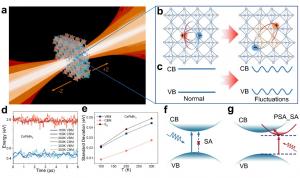Exciton-polaron-induced sub-bandgap ultrafast saturable absorption in perovskite CsPbBr3
A new mechanism for ultrafast nonlinear optical absorption
CHENGDU, SICHUAN, CHINA, June 19, 2025 /EINPresswire.com/ -- Check the full article here: https://www.oejournal.org/article/doi/10.29026/oea.2025.240312In recent years, low-dimensional materials have become a hot spot for nonlinear optics research due to their unique electronic structure and optical properties. However, how to achieve more significant nonlinear optical responses in low-dimensional materials and actively modulate their properties remains an important challenge in current research. To this end, researchers have explored various strategies such as electric field modulation, excitation resonance and heterostructure construction to enhance the ultrafast nonlinear optical response of materials.
Polarons, as quasiparticles formed by the strong interaction between carriers and lattice vibrations, can significantly modulate the band gap, carrier mobility, diffusion, composite and other properties of functional materials, which has become a research hot research topic in recent years. Soft lattice lead halide chalcogenides exhibit strong electron-phonon coupling effects due to their unique polarity and dynamic disorder, which provides an ideal environment for the formation of this polarons. Polarons can also achieve the modulation of the optical properties of materials, such as the formation of polarons can promote the efficient upconversion of photons. However, the direct correlation between polaronic states and nonlinear optical response of low-dimensional has not been fully investigated.
Recently, the research group of Prof. Jun He and Associate Prof. Yingwei Wang from the School of Physics, Central South University observed the polaronic state assisted sub-bandgap saturable absorption phenomenon in soft lattice lead halide perovskite (CsPbBr3), and revealed its physical mechanism through multi-dimensional experiments and theoretical calculations. This work was published as “Observation of polaronic state assisted sub-bandgap saturable absorption” in Issue x, 2025 of Opto-Electronic Advances.
The research team utilized femtosecond Z-scan technology to observe anomalous saturable absorption behavior in CsPbBr3 thin films when the photon energy was below the bandgap (redshifted by up to 60 meV). This phenomenon breaks the conventional limitation in semiconductors where sub-bandgap photons typically cannot induce saturable absorption, providing a new perspective for nonlinear optical absorption research. Based on the "soft lattice" characteristic of perovskite materials, a new mechanism of polaronic state assisted nonlinear saturable absorption was proposed: the band energy fluctuations induced by lattice polarons in perovskites enable saturable absorption via polaronic states under sub-bandgap excitation, as illustrated in Figure 1. This mechanism is supported by the following key experimental evidence: the phonon-assisted upconversion photoluminescence spectrum exhibits an anti-Stokes shift of 70 meV; the transient absorption spectrum reveals a prolonged exciton band bleaching rise time of 0.6 ps under sub-bandgap excitation; and a similar saturable absorption phenomenon under sub-bandgap excitation is verified in Cs4PbBr6 perovskite with softer lattice characteristic, where the energy shift of polaronic state assisted nonlinear saturable absorption becomes even more pronounced.
This study not only reveals the novel role of polaronic state in nonlinear photonics, but also provides a material platform for the development of tunable optoelectronic devices (such as low-threshold optical switches and broadband optical modulators). By modulating the lattice structure or dimensional properties of perovskites, the polaronic effect can be further optimized, and its applications in quantum technology or integrated photonics can be expanded.
Jun He, a Professor (Level II) and doctoral supervisor at Central South University, is a recipient of the National Science Fund for Excellent Young Scholars. He serves as a Member of the University Party Standing Committee, Vice President, and Chairman of the Overseas Chinese Federation at Central South University. His research focuses on ultrafast nonlinear optics, novel optoelectronic functional materials and devices, and semiconductor spintronics. Professor He has published over 340 SCI-indexed papers in prestigious international journals including Nat. Mater., Nat. Commun., and Phys. Rev. Lett., with more than 11,000 citations and an h-index of 59. He has been recognized as a Highly Cited Researcher by Clarivate Analytics and ranked among the world's top 2% most-cited scientists. Since 2020, he has published 62 papers as first or corresponding author, including 46 papers in JCR Q1 journals, 22 papers with impact factors exceeding 10, and one paper with a maximum impact factor of 41.2. He has led four National Natural Science Foundation of China projects and authored two academic monographs. His honors include the Second Prize of Hunan Natural Science Award (first-ranked recipient) and the Silver Medal at the Geneva International Exhibition of Inventions (second-ranked recipient).
Yingwei Wang, an Associate Professor at Central South University, is a recipient of Hunan Provincial Outstanding Youth Fund and a “Shenghua Scholar” at Central South University. He focuses on the field of nanophotonics of low-dimensional materials and conducts fundamental and applied fundamental research on the interaction between lasers and matter. He has made a series of key progress in the ultrafast nonlinear optical effects of low-dimensional materials. As the first author or corresponding author, he has published 42 SCI papers in internationally renowned journals such as Chem. Soc. Rev., Nano Lett., ACS Nano, Adv. Funct. Mater., Adv. Sci., and Opto-Electron. Adv., including 4 ESI highly cited papers, with over 3,000 SCI citations and an h-index of 27. He has led 6 national and provincial-level projects. He has won one second prize of the Natural Science Award of Hunan Province (3/6), and two Optical Science and Technology Progress Awards of Hunan Province, including one first prize (1/5) and one second prize (2/5). He serves as a Youth Committee Member of the Hunan Optical Society, a Young Editorial Board Member for the Journal of Central South University, and a Young Editorial Board Member for Acta Photonica Sinica.
Andrew Smith
Charlesworth
+44 7753 374162
marketing@charlesworth-group.com
Visit us on social media:
LinkedIn
YouTube
Other
Legal Disclaimer:
EIN Presswire provides this news content "as is" without warranty of any kind. We do not accept any responsibility or liability for the accuracy, content, images, videos, licenses, completeness, legality, or reliability of the information contained in this article. If you have any complaints or copyright issues related to this article, kindly contact the author above.

